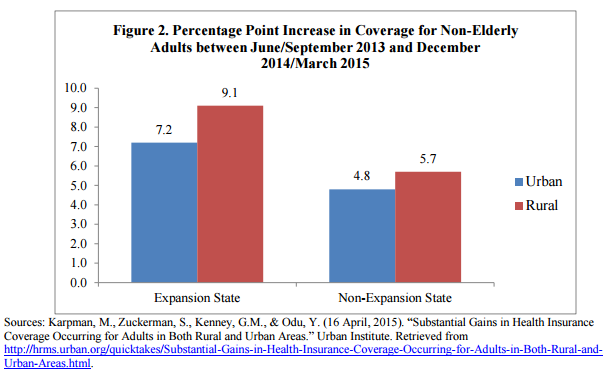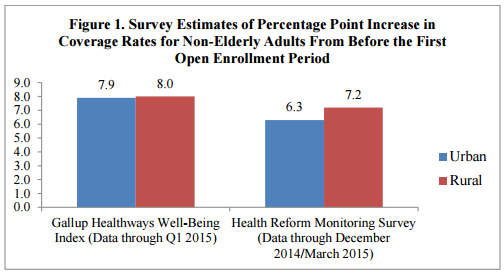Affordable Care Act Brought Healthcare Coverage to Rural Areas
“The Affordable Care Act has helped millions of people in rural areas access quality, affordable health coverage.”

- The Patient Protection and Affordable Care Act has brought a fair amount of healthcare access and coverage to the American people. This does not just include those living in urban areas or the suburbs. Recent research suggests that the Affordable Care Act has made a significant impact on improving healthcare coverage among Americans residing in rural regions.

Last week, the Department of Health & Human Services (HHS) released a report showing that the ACA has made health insurance available to those living in rural areas, according to a press release from HHS.
When looking at the health insurance rates in rural areas, an 8 percent increase is visible between the end of 2013 to the beginnings of 2015. Additionally, the number of people living in the countryside and unable to access affordable medical services plummeted about 6 percent.
“The Affordable Care Act has helped millions of people in rural areas access quality, affordable health coverage,” HHS Secretary Sylvia M. Burwell said in a public statement. “As someone from rural America, I know how important these gains in coverage and access to care are to communities like my hometown of Hinton, West Virginia.”
Additionally, HHS mentions how the tax credits have made premiums affordable since the costs of monthly premiums only rose an average of 4 percent or $5 per month for those eligible for the subsidies.
Even individuals who reside in the 19 states that did not expand the Medicaid program have benefited from the tax subsidies offered on the health insurance exchange. More people have the opportunity to purchase health plans from the federal exchange and not worry about high-cost premiums due to the subsidies.
In fact, their insurance rates are on par with people living in cities. This shows what a large impact the Affordable Care Act had on health insurance coverage across the country. However, it is important to point out that there has been a coverage gap due to the states that decline to partake in Medicaid expansion. More access to care could be brought to rural areas if the remaining states choose to expand their Medicaid coverage.
The report from HHS illustrated how non-expansion states have not seen as great of an increase in healthcare coverage when compared to states that took part in Medicaid expansion.
“Provisions of the Affordable Care Act have helped improve health insurance coverage and access to care across rural and urban areas. Rural individuals comprise nearly 1 in 5 Marketplace plan selections and, due to the design of premium tax credits, the increase in average net monthly premium among rural individuals with tax credits was $5 a month between 2015 and 2016,” the HHS report stated.
“Despite being disproportionately likely to live in states that have not expanded Medicaid, rural individuals have seen similar coverage gains under the ACA as other individuals, because they have been major beneficiaries from access to the Health Insurance Marketplace, from the ACA’s other coverage reforms, and from Medicaid expansion in states that chose to expand. Rural individuals would be expected to benefit disproportionately if the remaining 19 states chose to take up the ACA’s Medicaid expansion.”
Along with the tax credits that make health plans more affordable, consumers no longer have to fear pre-existing conditions from keeping coverage at bay since the Affordable Care Act eliminated such clauses from health plans around the country.
When looking at state populations in which the federal health insurance exchange operates, 1.7 million Americans residing in rural areas purchased health plans from the marketplace in 2016, the report found. In fact, these particular populations accounted for 20 percent of all health plans purchased on the federal exchange, HHS stated.
The report also discovered that there was an 11 percent rise from 2015 among rural Americans who purchased health plans through the federal marketplace. Health plans on the exchanges remain affordable for low-income families, which shows how the federal government has worked to expand access to medical services and bring a greater guarantee that healthcare is a right in this country.
The report from HHS outlines how both Medicaid expansion and the federal health insurance exchange led to a drop in the uninsured rates in both rural and suburban communities ever since the Affordable Care Act took effect. While the insurance rates rose 8 percent among rural Americans, those living in the suburbs also saw an increase of 7.9 percent.
This shows that the Affordable Care Act continues to have an impact on improving access to healthcare coverage around the country. If the legislation continues to operate and reforms are aligned with consumer needs, future public health should rise in quality and patient outcomes.
Image Credits: Department of Health & Human Services
Dig Deeper:
Affordable Care Act Brought 30% Drop for Texas Uninsured Rate
Affordable Care Act Brought the Uninsured Rate to 9.1%


